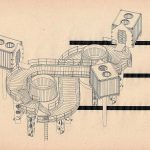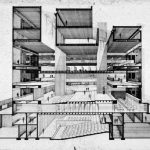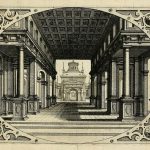
Gunter Rambow, “Utopie Dynamit” (1976)
If a mantra could define the present-day architectural debate, it would surely be the assertive claim that “Architecture is Always Political,” echoing the original late 1960s feminist slogan “The personal is political.” After more than twenty years of apparent disengagement from all things political—manifested in the anti-ideological practices often implied in figures like Rem Koolhaas’ cynicism or Eisenman’s post-functionalism—the 2010s have witnessed a resurgence of political statements shaping online discussions, debates, and entire architectural practices.
In an era overwhelmingly dominated by the forces of capital, there is a widely held belief that the realm of design is inevitably entangled with existing power structures. Nevertheless, as entire bodies of work from the past fifty years are increasingly rediscovered (as evidenced by the sudden renewed interest in the European architectural avant-gardes of the 1960s and 1970s), a new generation of practitioners is challenging this perspective, reasserting the central relevance of architecture within political struggles.
Social and political engagement is evident across practices occupying opposite ends of today’s production spectrum: from academically-oriented offices like the Italian-Belgian Dogma, which describes its work as being “within and against Capitalism,” to practitioners like Americans Teddy Cruz or Alejandro Aravena, whose engagement appears both socially conscious and appealing to the public.
However, while architects are once again acknowledging their involvement within the capitalist mode of production, the true “political” nature of architecture remains an ambiguous question. Recent discussions on social networks, reviews of significant exhibitions (such as Pedro Gadanho’s “9 + 1 Ways of Being Political: 50 Years of Political Stances in Architecture and Urban Design”), and debates surrounding events like the NYC book release of “Architecture and capitalism (2013)” at the Storefront for Art and Architecture, have all revolved around this question.
A notable exchange occurred between Ross Wolfe and Quilian Riano, which we could further engage with by reposting Wolfe’s latest commentary here on Socks, as readers of Wolfe’s blog.
“The assertion that all architecture or design is political (or unpolitical, for that matter) begs the question of what is meant by “politics.” Rather than simply ask whether or not architecture is political, we might ask how it is political. More radically still, we might question what counts as political in the first place. All too often, though perhaps as an understandable counterweight to la grande politique of the nineteenth and early twentieth centuries, everyday acts of “collusion” or “resistance” are held up as the primary site of political activity. Such so-called “micropolitics,” it is assumed, will cumulatively bring about the overthrow or restoration of the existing state of affairs. Micropolitics have been exalted, not accidentally, in exact proportion to the dwindling of revolutionary prospects in the most advanced capitalist nations of the world.”
“Is all Architecture Truly Political?”
A response to Quilian Riano
Quilian Riano has written up a brief piece, “Design as a Political Act,” over at Quaderns in which he responds in passing to some critical remarks I made about his comments in a recent event review and further contextualizes what he meant by his contention that “all architecture is political.”
Riano explains that this remark is not only intended as a statement of fact (though he goes on to maintain its factuality, with a few minor qualifications) but also as a corrective to the formalistic (mis)education most architects receive in the course of their training. He lays much of the blame for this at the feet of the architect Peter Eisenman, whose post-functionalist perspective disavows any possible political role for design. In this, Riano is doubtless on the right track in his skepticism toward Eisenman’s views. The oldest ideology on the books, after all, is that which most adamantly insists on its apolitical or non-ideological character.
Nevertheless, I cannot help but feel that Riano overcompensates in issuing this corrective. To claim that all design is political is no more accurate than to claim that design isn’t political at all. In either case, the counterclaim expresses an abstract, contentless universality — almost in the same manner that, for Hegel in his Science of Logic, an ontological plenum (where everything’s filled in) and an ontological void (where nothing’s filled in) are conceptually identical. Žižek, whose interview withVice magazine Riano cites, would probably appreciate this analogy. Seemingly opposite claims, by remaining at this level of abstraction, are equidistant from reality. Clearly, Riano has “bent the stick too far in the other direction,” as the saying goes.

Model, Tribune for a Leninist (the podium sits empty, the placard reads “Glasnost”)
It’s an odd position to be in, coming to the defense of a figure one generally finds unsympathetic, but whose work is being criticized unjustly. So it is with someone like Eisenman. Here I’m reminded of something Douglas Murphy said to me a couple months back. Murphy, who was unsparingly critical of Eisenman in his debut, The Architecture of Failure, told me he’d recently “found [him]self…defending Peter Eisenman, reactionary old windbag though he is, against charges that he (and he alone!) ruined architectural education in the last 30 years.” Eisenman is not so much the cause as the effect of the depoliticization of architecture.
Acknowledging one’s implication within the dominant, by now global, capitalist mode of production is certainly a first step. This does not invalidate the point, argued for by Deamer (though dismissed by the other panelists) that urbanism appears closer to the proverbial “base” of social production and architecture closer to the proverbial “superstructure.” In general, I think Riano and the others, even Sorkin, garble the whole base-superstructure distinction, even if it can be little crude, linear, and mechanistic in the hands of some. Sorkin prefers the phrase “false consciousness,” which Engels suggested in a letter to Mehring in 1893, probably on account of the frequent misuse to which the language of “base” and “superstructure” is often put. Even so, I think the original formulation from Marx’s Contribution to a Critique of Political Economy (1859) is defensible, but this will have to wait for another post.
For now, it is enough to commend Riano on the valid insight contained in the following excerpt:
Presently architects who ask questions of the role of capital are labeled as political or activist architects. These monikers obscure the fact that we are all involved in the complex capitalist processes that produce a building, a space, a city. No one producing form can claim innocence.
Illusions of “innocence” are often sustained by one’s lofty political ideals or supposed social commitments. Riano is fully justified to point out the unavoidable “complicity” of the architect or designer with the economic processes that enable his practice. None should be so naïve as to think that it’s possible to operate wholly outside networks of exchange. Nevertheless, there’s a way this argument can be made that’s actually quite superficial and misleading, and must thus be guarded against.

Observation tower, OMA’s Boompjes Project (1980) – Martin Gittins argues is modeled on Lenin Tribune
To illustrate, such an admission might appear, prima facie, to lend weight to Riano’s prior contention that all architecture is political. By upholding the political culpability of the architect in every instance of collateral exploitation, expropriation, and eviction (even if merely incidental to the construction of a given building), one could insinuate the converse is also true: whatever benefits accrue from its construction — i.e., the gainful employment of those workers recruited for its assembly, the increased property value of the surrounding neighborhood or city, the improved quality of life of its inhabitants — can be considered the payoff, the positive political achievement of the architect. One hand washes the other. Perhaps Riano is willing to assign responsibility to architects for the bad so long as they can also claim credit for the good.
Again, to argue that the results of such design choices, whether beneficial or detrimental, can ever add up to a politics ends up inflating the significance of the architect in society. Except in truly iconic productions, or maybe planning projects on the scale of a major city (think of Haussmann’s Paris, explicitly intended to quell potential uprisings), the minor “goods” and “evils” with which architecture and urbanism are bound up are seldom of political consequence. More often than not, the only politics either can claim is thus its participation in the reproduction of existing social relations, with perhaps some limited benefits or detriments for whoever lives there, or lives around it, or is involved in building the thing. Unless it is part of a broader program, even a blandly reformist agenda like in Red Vienna or Weimar Germany during the interwar period, architecture and urbanism can be politically important only insofar as they are emblematic or experimentally reproducible. Only then could it really claim to be involved in the transformation of existing social relations.
The assertion that all architecture or design is political (or unpolitical, for that matter) begs the question of what is meant by “politics.” Rather than simply ask whether or not architecture is political, we might ask how it is political. More radically still, we might question what counts as political in the first place. All too often, though perhaps as an understandable counterweight to la grande politique of the nineteenth and early twentieth centuries, everyday acts of “collusion” or “resistance” are held up as the primary site of political activity. Such so-called “micropolitics,” it is assumed, will cumulatively bring about the overthrow or restoration of the existing state of affairs. Micropolitics have been exalted, not accidentally, in exact proportion to the dwindling of revolutionary prospects in the most advanced capitalist nations of the world.

El Lissitzky, Lenin Tribune proposal (1920-1924)
When it comes to the choices individual architects make in employing/exploiting (for Marxists this amounts to the same thing) certain kinds of labor in the construction of their buildings — i.e., fairly compensated, unionized workers or hyper-exploited immigrants — or selecting materials gathered by certain means — i.e., fairly compensated, unionized workers or hyper-exploited immigrants — these choices are less properly political than they are ethical. The same might be said of “sweetheart deals,” instances of corruption where, for example, municipal funds are allocated to pay a construction company owned by the mayor’s cousin. Dropping architecture’s pretension to independent political agency does not mean that architecture cannot be positively or negatively evaluated. It means that evaluations of “good” or “bad” are made instead with reference to ethics or architectural form. Knowingly employing only the cheapest possible labor for private economic gain may be ethically questionable, but it says nothing of one’s political worldview. Likewise, designing a bathroom in an apartment poorly might make one a bad architect, but it hardly makes him a reactionary.





See Quilian Riano’s response to Ross Wolfe here:
http://dsgnagnc.com/from-affirmations-to-disruptions-understanding-design-as-a-political-act/
FROM AFFIRMATIONS TO DISRUPTIONS: UNDERSTANDING DESIGN AS A POLITICAL ACT
“It has to be said that historically, the connection between capital and architecture has not been so mysterious; architects in the not so distant (European) past actually did build their practices around their overtly formulated economic positions.”
-From Peggy Deamer’s introduction to Architecture and Capitalism
[The text in this blog post was first published in Quaderns. ]
Last week, during a public conversation at the Storefront for Art and Architecture for the book launch of Architecture and Capitalism, I said that “all design is a political act.” This made blogger Ross Wolfe cringe in an opinion piece about the event in Quaderns. In his piece, Mr. Wolfe consistently ignores the context for the event and for many of the remarks from that evening. I will, however, take this as an opportunity to give just such context to my remarks and expand on what I meant.
First, I invite everyone to see the entire discussion online and to read a short post I wrote after the event summarizing and expanding on my thoughts on a previous blog post: Architecture and/or Capitalism Conversation.
The discussion began with moderator Peggy Deamer bringing up a claim she made in the book regarding the Marxist distinction between superstructure and base. In the introduction, she claims that architecture primarily functions in the superstructure, in the “realm of culture, allowing capital to do its work without its effects being scrutinized.” In the conversation, she posed the question of whether urbanism, because of its more clear ties to the economy, resides more in the base. All panelists promptly dismissed the binary as unhelpful and perhaps even dangerous. As part of my response, I stated that is important to keep in mind that both architectural and urban form are the result of political and economic forces.
As we continued to discuss that statement, it became clear that we were all troubled by how the role of capital is almost completely obscured in architectural practice. In architectural offices, designers make decisions every day while ignoring potential political consequences, such as labor conditions and environmental impacts. We then talked about the need to confront this willful ignorance.
When I said that all design is a political act, I meant it both as a statement and as a question to provoke further discussion. Why is it important to state such a seemingly obvious point? Because architecture is not often discussed that way, especially in academia or in practice. I often go to reviews where students and faculty only discuss the formal aspects of projects, ignoring all social and political conditions produced by or enabling the work. This is in part because the post-functionalist ideas popularized by Peter Eisenman are now the predominant ideology of architecture schools, especially in the U.S. This ideology claims that architecture should only work within formal discourses, rejecting any political discourse in what can be seen as an over-reaction to the failure of heroically humanist discourses of the late-modernist period. Eisenman has gone as far as to claim that “Liberal Views Have Never Built Anything of any Value.” These views are so ingrained in the field that even emerging practitioners espouse them as given truths as seen in a recent interview with Jimenez Lai who said: “When people talk about being more than just architects, about solving other world problems —affordable housing, carbon emission, landscape urbanism—in my mind, they’re effectively forfeiting the very thing they’re supposed to be an expert on. If we’re not going to cultivate formalism, who will?”
Image of a Peter Eisenman-designed house with glass slot in the center of the wall continuing through the floor that divides the room in half, forcing there to be separate beds on either side of the room so that the couple was forced to sleep apart from each other. ArchDaily/NJIT
Image of a Peter Eisenman-designed house with glass slot in the center of the wall continuing through the floor that divides the room in half, forcing there to be separate beds on either side of the room so that the couple was forced to sleep apart from each other. ArchDaily/NJIT
Furthermore, most often professors and practitioners who talk about larger political processes at all do it with the ironic detachment that has at times has been the modus operandi of one of the most prominent architectural practices, Rem Koolhaas’ Office for Metropolitan Architecture. In fact, one of my favorite essays in Architecture and Capitalism is “Irrational Exuberance: Rem Koolhaas and the 1990’s” by Ellen Dunham-Jones — you can read an excerpt of it in Places Journal. In the essay, Dunham-Jones says the following about Koolhaas’ ironic flirtation with capitalism:
“Nonetheless, over the decade, his writings and designs contributed significantly to shifting design discourse away from critical theory toward post-critical, non-judgmental research, and from autonomy toward engagement — albeit engagement largely with the elite beneficiaries of the New Economy, now often described as “the 1%.” From our contemporary perspective, it is thus worth asking: What is Koolhaas’s legacy vis-à-vis progressive practice?” (Page 151)
In the current context of architectural production, politics are either ignored and not thought to be important for form-making or referred to ironically, without any real consequence.
From Content, by OMA/Koolhaas (Taschen, 2004).
From Content, by OMA/Koolhaas (Taschen, 2004).
What I am concerned with is ways in which we can begin to ask political questions in architectural studios in academia and practice. I will posit that the first step is a reaffirmation that all architecture formalizes invisible forces and ideologies. A similar sentiment was expressed humorously and concisely by Slavoj Zizek in a Vice interview. In discussing postmodern companies and bosses that try to hide their power by dressing and acting casually, Zizek says that “the first step to liberation is to force him[/her] to act like a boss. Stop acting like a friend and give me orders.” Similarly, one of the first steps we need to take towards liberation is to recognize capital’s power lest one get seduced by the seemingly casual air of boutique architectural practices and tactical urbanism salons. Only then can we begin to have a conversation on how architecture can participate in formulating alternatives.
Presently architects who ask questions of the role of capital are labeled as political or activist architects. These monikers obscure the fact that we are all involved in the complex capitalist processes that produce a building, a space, a city. No one producing form can claim innocence.
Do we then need to stop practicing as architects? No!
Recognizing that current architectural practice is inextricable from capitalist processes can inject political discourse back into the discipline. Many architects, artists and designers are beginning practices that reject unrealizable utopianism and instead take on existing systems of power. These practices seek to understand and illuminate systems of power in order to change them. A project that attempts to enact such change, from outside of architecture, is Strike Debt! a project started by artists that effectively intervenes in the U.S. debt system.
This project points towards the potential of designing actions that are intentionally shaped by political forces and in turn are designed to push back on those forces. The Storefront was filled to capacity for this event, showing that architects, in fact, want to engage in critical political discourses. Perhaps this also signalled a clear dissatisfaction with the notion that we can do nothing in the face of a complex global capitalist system. A reaction against the notion that we cannot act critically on the city. There may be a time for a more fully utopian moment — for a revolution —but for now we can use design to illuminate systems of power and strategically act on them.
BY QUILIAN RIANO
11.13.13 UPDATE: The conversation has continued on the comments sections of the Quaderns post and over several days in twitter with many voices joining. During the many great discussions I was reminded of Keller Easterling’s excellent essay “out-maneuvered by stupidity’s agility” in “Did Someone Say Participate?” In that essay Easterling says the following about the potential role of architecture in the current political environment:
Righteous political resistance, sure of its central principles, strangely resembles the righteous tautologies of stupidity itself. Righteousness even fuels stupidity’s tendency to symmetrical deadlock. Moreover, the principled stances of political resistance are out-maneuvered by stupidity’s agility with multiple fictions. Certainly some of the classic powers associated with the proletariat apply to a worker who no longer exists. A resistance that protects authentic locality not only protects an impossible fiction in a world where capital is flowing in all directions, and sets up future targets for abuse. Yet just as the utopia of the park turns into its supposed opposite — a ubiquitous condition — so the state of political immunity and exception may turn into its opposite: resistance. Exception, as its alternately understood to mean a temporary or unique opportunity, can create both interior and exterior conditions that place the park in the crosshairs of the political conflict that it attempts to banish. These opportunities may be most effective not when they righteously and officially square up to the problem, but when they invent an ingenious ricochet that changes the terms of the situation.
In this light, tools like architecture and urbanism, which seem to be innocent of political dealings, may be particularly well suited to send in a new technology or logistical wrinkle — one that tips the power of the lockdown towards other political contingencies. Resistance too may adopt stupidity’s agility to manipulate and confound the world’s most abusive situations – if it is too smart to be right.
Also see:
http://dsgnagnc.com/architecture-andor-capitalism-conversation/